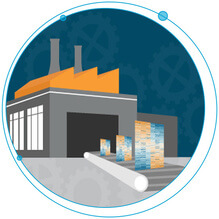 High Throughput, Robust, Sample Analysis with Microflow SWATH® Acquisition
High Throughput, Robust, Sample Analysis with Microflow SWATH® Acquisition
Part 1 of a 3-Part Blog Series
Many groups around the world are now using SWATH Acquisition on TripleTOF Systems for both quantitative proteomics experiments and biomarker research. The SWATH acquisition technique on a TripleTOF® 6600 system provides state-of-the-art quantitative proteomics analysis with unrivaled proteome coverage. With this workflow, researchers can routinely quantify 1000s of proteins per run, reproducibly, and with high data completeness – all with the quantitative accuracy approaching that of a gold standard MRM approach.
But both traditional and translational research programs are studying larger sample sets, leading to higher demands on throughput and turnaround time. There is an increasing focus on Precision Medicine, and the promise is to be able to tailor medical decisions and practices to individual patient needs. But the success of this approach depends on a repository of biological knowledge that reflects the diversity of the population. Thus, larger cohort studies are being undertaken which raise new questions for proteomics experiments. How can we move these large cohorts through translational research faster? How can we best support longitudinal studies on large populations over time?
In this three-part blog series, we’ll show you how to industrialize your quantitative proteomics workflow so that you can increase your throughput to meet the demands of today’s research pace. In this first blog, we’ll explore our sample analysis workflow. Traditionally, proteomics LC-MS experiments have been performed using nanoflow LC to gain the maximum sensitivity. Thus, one of the main limitations on throughput is the total LC turn-around time from run to run (including equilibration time and LC gradient/separation time). Higher flow chromatography could certainly increase throughput but with a loss in sensitivity. It turns out that microflow LC is a good compromise. With just a small loss in sensitivity, microflow LC can provide increased throughput, plus many additional benefits as described below, vs. a traditional nanoflow LC approach.
In a recent technical note1and webinar2, SCIEX researchers explored the differences between using nanoflow vs. microflow LC. Here, a SWATH analysis of a trypsin digest of a HEK cell lysate was performed on a NanoLC™ 425 System operating at 5 µL/min and analyzed using a TripleTOF 6600 System. Instead of a nanoflow source, the more robust DuoSpray™ Source equipped with the 25 µm hybrid electrode was used for ionization. The total run time from sample-to-sample was ~1 hour – a significant time saving vs. traditional nanoflow approaches. Microflow was able to quantify 85% of the proteins as compared to nanoflow studies performed using the same sample, but with huge gains in throughput – up to 400%! This is a good tradeoff when throughput is required for larger studies and when more sample amount is available.
Additionally, excellent retention time stability was observed over multiple injections with deviations of 10 seconds or less across the gradient (technical note1).
The increased flow rate also provides a significant improvement in ease of operation. Flow path connections are more straightforward to make and troubleshoot. The DuoSpray source (designed for the high throughput environment) can be used instead of the NanoSpray® source for nanoflow LC. Post-column dead volume is reduced. Faster load and equilibration times can be achieved. All of this adds up to improved robustness and faster turn-around time.
And because the NanoLC 425 System has the capability to operate in both the nanoflow regime as well as the microflow regime, it’s easy to take your research to the next level. With a 1 hour gradient, 20 – 24 samples can be analyzed per day depending on the # of QC runs desired. That’s up to 150 proteomes per week! How’s that for throughput versus nanoflow!
Is your research ready for an industrial revolution?
To learn more about how you can improve your efficiency and output for your quantitative proteomics research, read the full technical note, view the webinar, and read part 2 and part 3 of this blog series.
References
- Microflow SWATH Acquisition for Industrialized Quantitative Proteomics
- Webinar: Industrializing Quantitative Proteomics using Microflow LC and SWATH Acquisition – Christie Hunter, April 27th






 Contact Support
Contact Support
0 Comments